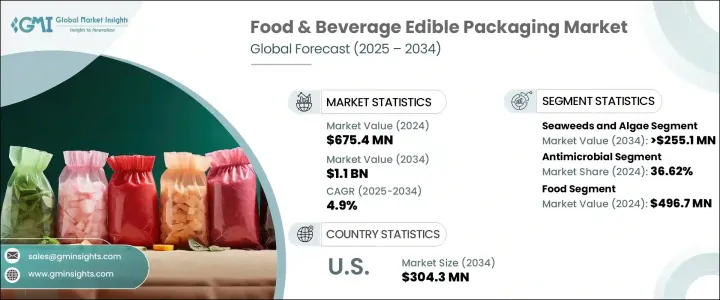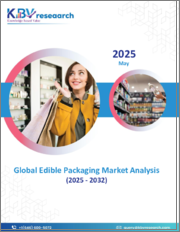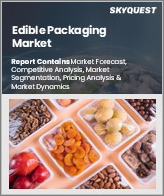
|
시장보고서
상품코드
1708231
식품 및 음료용 식용 포장 시장 기회, 성장 촉진요인, 산업 동향 분석, 예측(2025-2034년)Food and Beverage Edible Packaging Market Opportunity, Growth Drivers, Industry Trend Analysis, and Forecast 2025 - 2034 |
||||||
세계의 식품 및 음료용 식용 포장 시장은 2024년에 6억 7,540만 달러에 달하며, 2025-2034년에 CAGR 4.9%로 성장할 것으로 예측됩니다.
이러한 성장의 주요 요인은 지속가능한 포장 솔루션에 대한 소비자 수요 증가에 기인합니다. 플라스틱 폐기물 감소에 대한 필요성이 증가함에 따라 업계는 생분해성 및 천연 대체 포장재로 전환하고 있습니다. 환경에 미치는 영향이 적고 폐기물을 적게 발생시키는 것으로 알려진 식용 포장재는 식품 및 음료 분야에서 많은 지지를 받고 있습니다. 지속가능한 관행에 대한 규제적 의무와 소비자의 기대는 기업이 환경 친화적 가치에 부합하는 혁신적인 솔루션을 채택하도록 압박하고 있습니다. 현재 많은 브랜드들이 환경 친화적인 소비자를 끌어들이기 위해 식물성 및 퇴비화 가능한 소재를 선택하고 있으며, 이는 식용 포장에 대한 수요를 크게 증가시키고 있습니다.

시장은 해조류/조류, 다당류, 지질, 기타 카테고리를 포함한 원료별로 분류됩니다. 해조류 및 조류는 높은 생분해성, 우수한 영양학적 특성, 포장용도에 적합한 강하고 유연한 필름을 만들 수 있는 능력으로 인해 2034년까지 2억 5,510만 달러를 넘어설 것으로 예측됩니다. 조류 필름 및 코팅에 대한 투자가 증가하는 것은 우수한 산소 차단 특성으로 인해 식품의 저장 기간을 효과적으로 연장하고 식품의 저장성을 향상시킬 수 있기 때문입니다. 폐기물 제로 포장에 대한 소비자의 관심이 높아지면서 해조류 기반 대체품에 대한 수요가 더욱 증가하여 이 분야가 크게 성장하고 있습니다.
| 시장 범위 | |
|---|---|
| 시작연도 | 2024년 |
| 예측연도 | 2025-2034년 |
| 시작 금액 | 6억 7,540만 달러 |
| 예상 금액 | 11억 달러 |
| CAGR | 4.9% |
시장은 또한 항균, 나노테크놀러지, 전기수력학, 코팅, 미생물 등 포장 공정별로 분류됩니다. 항균 부문은 2024년 시장 점유율 36.62%를 차지할 것으로 예상되며, 미생물 오염 방지, 식품 안전성 향상, 유통기한 연장에 효과적이기 때문에 향후에도 우위를 유지할 것으로 예측됩니다. 소비자와 규제 당국이 방부제를 사용하지 않는 자연 식품 포장 방법을 점점 더 선호함에 따라 항균 식용 포장재가 매우 적합한 선택으로 떠오르고 있습니다. 이러한 자연 보존으로의 전환은 식품 포장의 합성 첨가제 감소라는 광범위한 추세와 일치합니다.
최종 용도 측면에서 시장은 식품과 식품 및 음료로 나뉩니다. 폐기물을 줄이는 지속가능하고 영양가 있는 포장을 찾는 소비자가 증가함에 따라 식품 부문이 2024년 4억 9,670만 달러로 시장을 주도할 것으로 예측됩니다. 특히 플라스틱 폐기물로 인한 오염에 대한 인식이 높아지면서 식품 제조업체들은 환경에 미치는 영향을 최소화하고 신선도를 유지하기 위해 생분해성 식용 필름, 포장지, 보호 코팅을 채택하고 있습니다. 베이커리, 제과, 유제품, 육류, 신선식품 등의 업계는 소비자의 기호 변화에 대응하기 위해 이러한 지속가능한 포장 솔루션을 채택하고 있습니다.
지역별로는 북미 시장이 2034년까지 3억 8,430만 달러에 달할 것으로 예측되며, 미국이 3억 430만 달러의 기여로 성장을 선도하고 있습니다. 이러한 성장은 일회용 플라스틱 금지령의 채택 증가, 생분해성 포장 기술에 대한 투자 증가, 지속가능한 제품에 대한 소비 지출 증가에 기인합니다. 미국 식품의약국(FDA)과 환경보호청(EPA)과 같은 규제 당국은 플라스틱 폐기물을 줄이기 위해 엄격한 조치를 시행하고 있으며, 이는 이 지역에서 친환경 식용 포장에 대한 기회를 창출하고 있습니다.
목차
제1장 조사 방법과 조사 범위
제2장 개요
제3장 업계 인사이트
- 에코시스템 분석
- 업계에 대한 영향요인
- 촉진요인
- 지속가능성에 대한 소비자의 수요 증가
- 식용 필름과 코팅의 진보
- 기능성 포장을 추진하는 건강지향 소비자
- 식품 택배와 온·더·고 수요의 확대
- 생분해성 포장을 촉진하는 정부의 규제
- 업계의 잠재적 리스크 & 과제
- 플라스틱에 비해 높은 제조 비용
- 한정된 보존 기간과 보관 과제
- 촉진요인
- 성장 가능성 분석
- 규제 상황
- 기술 동향
- 향후 시장 동향
- 갭 분석
- Porter의 산업 분석
- PESTEL 분석
제4장 경쟁 구도
- 서론
- 기업 점유율 분석
- 주요 시장 기업의 경쟁 분석
- 경쟁 포지셔닝 매트릭스
- 전략 대시보드
제5장 시장 추산·예측 : 원료별, 2021-2034년
- 주요 동향
- 해조·조류
- 다당류
- 지질
- 기타
제6장 시장 추산·예측 : 포장 프로세스별, 2021-2034년
- 주요 동향
- 항균
- 나노테크놀러지
- 전기 유체
- 코팅
- 미생물
제7장 시장 추산·예측 : 최종 용도별, 2021-2034년
- 주요 동향
- 식품
- 신선식품
- 베이커리·제과
- 포장 식품
- 음료
- 무알코올 음료
- 주류
제8장 시장 추산·예측 : 지역별, 2021-2034년
- 주요 동향
- 북미
- 미국
- 캐나다
- 유럽
- 독일
- 영국
- 프랑스
- 네덜란드
- 스페인
- 이탈리아
- 아시아태평양
- 중국
- 인도
- 일본
- 호주
- 한국
- 라틴아메리카
- 브라질
- 멕시코
- 아르헨티나
- 중동 및 아프리카
- 사우디아라비아
- 남아프리카공화국
- 아랍에미리트
제9장 기업 개요
- 1. Amtrex Nature Care Pvt Ltd
- 2. Devro
- 3. evoware
- 4. JRF TECHNOLOGY
- 5. Notpla Limited
- 6. Pace International, LLC
- 7. SUNPACK CORPORATION
- 8. TIPA LTD
- 9. Xampla
The Global Food & Beverage Edible Packaging Market reached USD 675.4 million in 2024 and is projected to grow at a CAGR of 4.9% between 2025 and 2034. This growth is primarily driven by rising consumer demand for sustainable packaging solutions. As the need for reducing plastic waste intensifies, industries are increasingly shifting toward biodegradable and natural packaging alternatives. Edible packaging, known for its minimal environmental impact and low waste generation, is gaining traction in the food and beverage sector. Regulatory mandates and consumer expectations for sustainable practices are pressuring companies to adopt innovative solutions that align with eco-conscious values. Many brands are now opting for plant-based and compostable materials to attract environmentally aware consumers, significantly boosting the demand for edible packaging.

The market is segmented by raw materials, including seaweeds and algae, polysaccharides, lipids, and other categories. Seaweeds and algae are expected to surpass USD 255.1 million by 2034 due to their high biodegradability, superior nutritional properties, and ability to create strong, flexible films suitable for packaging applications. Increasing investments in algae films and coatings are driven by their excellent oxygen barrier properties, which effectively extend shelf life and improve food preservation. Rising consumer interest in zero-waste packaging further enhances the demand for seaweed-based alternatives, positioning this segment for substantial growth.
| Market Scope | |
|---|---|
| Start Year | 2024 |
| Forecast Year | 2025-2034 |
| Start Value | $675.4 Million |
| Forecast Value | $1.1 Billion |
| CAGR | 4.9% |
The market is also categorized by packaging processes, including antimicrobial, nanotechnology, electrohydrodynamic, coatings, and microorganisms. The antimicrobial segment accounted for 36.62% of the market share in 2024 and is expected to continue dominating due to its effectiveness in preventing microbial contamination, enhancing food safety, and extending shelf life. As consumers and regulators increasingly prioritize preservative-free and natural food packaging methods, antimicrobial edible packaging emerges as a highly suitable option. This shift toward natural preservation aligns with the broader trend of reducing synthetic additives in food packaging.
In terms of end-use, the market is divided into food and beverages. The food segment dominated the market, accounting for USD 496.7 million in 2024, as more consumers demand sustainable and nutrient-rich packaging that reduces waste. Increased awareness of pollution, particularly from plastic waste, has prompted food manufacturers to adopt biodegradable edible films, wrappers, and protective coatings to preserve freshness while minimizing environmental impact. Industries such as bakery, confectionery, dairy, meat, and fresh produce have embraced these sustainable packaging solutions to meet evolving consumer preferences.
Geographically, the North American market is forecasted to reach USD 384.3 million by 2034, with the US leading the growth by contributing USD 304.3 million. This growth is attributed to the rising adoption of single-use plastic bans, increased investments in biodegradable packaging technologies, and growing consumer spending on sustainable products. Regulatory authorities such as the Food and Drug Administration (FDA) and the Environmental Protection Agency (EPA) are enforcing stringent measures to reduce plastic waste, creating opportunities for eco-friendly edible packaging in the region.
Table of Contents
Chapter 1 Methodology and Scope
- 1.1 Market scope and definitions
- 1.2 Research design
- 1.2.1 Research approach
- 1.2.2 Data collection methods
- 1.3 Base estimates and calculations
- 1.3.1 Base year calculation
- 1.3.2 Key trends for market estimation
- 1.4 Forecast model
- 1.5 Primary research and validation
- 1.5.1 Primary sources
- 1.5.2 Data mining sources
Chapter 2 Executive Summary
- 2.1 Industry 3600 synopsis
Chapter 3 Industry Insights
- 3.1 Industry ecosystem analysis
- 3.2 Industry impact forces
- 3.2.1 Growth drivers
- 3.2.1.1 Rising consumer demand for sustainability
- 3.2.1.2 Advancements in edible films and coatings
- 3.2.1.3 Health-conscious consumers driving functional packaging
- 3.2.1.4 Expanding food delivery and on-the-go demand
- 3.2.1.5 Government regulations promoting biodegradable packaging
- 3.2.2 Industry pitfalls and challenges
- 3.2.2.1 Higher production costs compared to plastics
- 3.2.2.2 Limited shelf life and storage challenges
- 3.2.1 Growth drivers
- 3.3 Growth potential analysis
- 3.4 Regulatory landscape
- 3.5 Technology landscape
- 3.6 Future market trends
- 3.7 Gap analysis
- 3.8 Porter's analysis
- 3.9 PESTEL analysis
Chapter 4 Competitive Landscape, 2024
- 4.1 Introduction
- 4.2 Company market share analysis
- 4.3 Competitive analysis of major market players
- 4.4 Competitive positioning matrix
- 4.5 Strategy dashboard
Chapter 5 Market Estimates and Forecast, By Raw Material, 2021 – 2034 ($ Mn)
- 5.1 Key trends
- 5.2 Seaweeds and algae
- 5.3 Polysaccharides
- 5.4 Lipids
- 5.5 Others
Chapter 6 Market Estimates and Forecast, By Packaging Process, 2021 – 2034 ($ Mn)
- 6.1 Key trends
- 6.2 Antimicrobial
- 6.3 Nanotechnology
- 6.4 Electrohydrodynamic
- 6.5 Coatings
- 6.6 Microorganisms
Chapter 7 Market Estimates and Forecast, By End Use, 2021 – 2034 ($ Mn)
- 7.1 Key trends
- 7.2 Food
- 7.2.1 Fresh foods
- 7.2.2 Bakery & confectionery products
- 7.2.3 Packaged foods
- 7.3 Beverages
- 7.3.1 Non-alcoholic beverages
- 7.3.2 Alcoholic beverages
Chapter 8 Market Estimates and Forecast, By Region, 2021 – 2034 ($ Mn)
- 8.1 Key trends
- 8.2 North America
- 8.2.1 U.S.
- 8.2.2 Canada
- 8.3 Europe
- 8.3.1 Germany
- 8.3.2 UK
- 8.3.3 France
- 8.3.4 Netherlands
- 8.3.5 Spain
- 8.3.6 Italy
- 8.4 Asia Pacific
- 8.4.1 China
- 8.4.2 India
- 8.4.3 Japan
- 8.4.4 Australia
- 8.4.5 South Korea
- 8.5 Latin America
- 8.5.1 Brazil
- 8.5.2 Mexico
- 8.5.3 Argentina
- 8.6 Middle East and Africa
- 8.6.1 Saudi Arabia
- 8.6.2 South Africa
- 8.6.3 UAE
Chapter 9 Company Profiles
- 1. Amtrex Nature Care Pvt Ltd
- 2. Devro
- 3. evoware
- 4. JRF TECHNOLOGY
- 5. Notpla Limited
- 6. Pace International, LLC
- 7. SUNPACK CORPORATION
- 8. TIPA LTD
- 9. Xampla



















